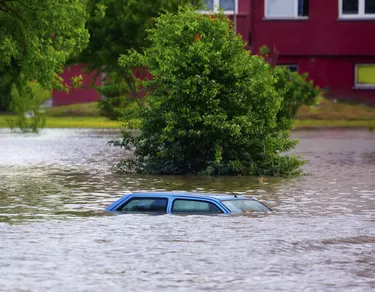
House lifting is a common mitigation practice to prevent flood damage by elevating a home to the base flood elevation or higher. Often seen on the hurricane-prone east and Gulf coasts, house lifting is used frequently on beach houses and riverfront homes. The federal government relies on an insurance program to protect citizens from flood damage, so grants for flood mitigation and recovery are rare. The government generally extends any available house lifting grants only to communities participating in its National Flood Insurance Program.
National Flood Insurance Program
Video of the Day
Congress established the NFIP in 1968 to provide affordable flood insurance to homeowners. The Federal Emergency Management Agency conducts flood analysis and creates flood maps, while the NFIP issues and administers flood insurance. Although any homeowner may purchase flood insurance the federal government requires those with homes in high-risk flood zones to do so. The Federal Deposit Insurance Corporation is the agency that enforces mandatory flood insurance purchases through banks and mortgage companies.
Video of the Day
Flood Mitigation Grants
Flood mitigation actions include raising a water heater onto cement blocks and they cost little, but house raising itself is expensive. FEMA does offer assistance through its Flood Mitigation Assistance Program and Severe Repetitive Loss Program, though individuals can't apply directly. States, tribal governments and NFIP-participating communities can apply for NFIP and SRLP grants and FEMA can also offer grants to sub-applicants. Flood mitigation sub-applicants must reside in an NFIP-participating community and must use funds solely for mitigation to the primary home residing withing the same community.
Flood Mitigation Assistance Program
1994's National Flood Insurance Reform Act created FEMA's Flood Mitigation Assistance Program to reduce or eliminate NFIP claims. FEMA awards FMAP funds to states and NFIP-participating communities to mitigate long-term flood risks to NFIP-insured buildings, mobile homes and other structures. FMAP project grants provide funds for mitigation measures such as structural elevation or house lifting and structural purchase or relocation. FMAP grant amounts also vary annually. FEMA also releases online updated FMAP application materials and instructions on an annual basis.
Severe Repetitive Loss Program
"Severe repetitive loss" refers to NFIP-insured residential property that required at least four NFIP claim payments of more than $5,000 each. SRL also involves at least two claim payments where the cumulative amount of the building's flood claim exceeded the market value of the structure. Plus, at least two of those flooding claims must have taken place within any 10-year period. FEMA makes SRL grants to states, territories and federally-recognized tribal governments on a 75 percent federal and 25 percent grantee cost share basis.
SRL Federal Cost Share
The federal portion of the SRL cost share may reach 90 percent for projects in states with FEMA-approved mitigation plans that include a mitigation strategy for severe repetitive loss properties. Federal SRL grant amounts vary annually. As with its other grant programs, FEMA provides its annually updated application and instructions on its website. States also follow FEMA guidelines and regulations for SRL program grant applications and funding amounts.